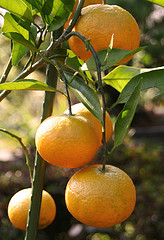Mandarins
| Infobox on Mandarins | |
|---|---|
| Example of Mandarins |  |
| Freshness facts | |
| Optimum carrying temperature | 4°C/8°C (Mandarins) 4°C/6°C (Clementines, Tangelo / Minneolas) |
| Highest freezing point | -1,1°C |
| Acceptable product temp. at loading into containers | Max. 5°C above carrying temperature |
| Optimum humidity | 90% |
| Ventilation setting for containers | 25 m³/hr |
| Storage life | 1 to 2 months |
| Climacteric / non-climacteric | Non-climacteric |
| Ethylene production | Very Low |
| Ethylene sensitivity | Moderate |
| Modified / controlled atmosphere | 0%-5% CO2; 5%-10% O2 |
| Potential benefits | Slight |
| Availability | |
| South Africa South America South Europe Egypt/Morocco |
May - August April - June November - February October - March |
Mandarins
Contents
Harvesting and handling
The mandarin is a fruit similar to the orange but smaller and flattened in its base. Its rd is smooth, shining red orange-coloured and very easy to peel, even with the hands. Soft citrus, easy peelers or mandarins are common names for these citrus cultivars. Fruit of these cultivars are normally softer than the known citrus fruit and have a loose skin that can easily be removed giving rise to these names.
Some of the commercial cultivars that are exported are Clementines, Clemenules, Ellendales, Minneolas, Satsumas and Tangerines. Fruit of these cultivars are very delicate in texture and flavour and are more temperature sensitive than the traditional oranges. Cooling as soon as possible after harvest and maintenance of the cold chain throughout is very important to maintain quality. Different fungicides are recommended as post harvest treatments.
Degreening with ethylene (to remove the chlorophyll from the peel) may be necessary for some citrus fruit. However, this can increase susceptibility to decay. The degree of ripeness of citrus fruit is determined by the Brix value, which is a measure of the sugar content of the fruit; Brix values of 12-16% are acceptable for good flavour quality. High quality mandarins will have a turgid, deep orange-red peel relatively free of blemishes. The fruit should be elliptical and firm. The peel should be easily removed from the flesh. The edible portion should be juicy and contain few or no seeds.
Cooling and storage
'Easy peelers' require adequate pre-cooling and continuous refrigeration at 4°C to 8°C and 90% relative humidity, under which conditions the fruit should keep for approx. 1-2 months. Storage duration depends on variety, maturity at harvest and decay control. Due to the high water content of this citrus fruit, a relative humidity of 90% is required. Inadequate ventilation may result in suffocation and breakdown of the cargo as a result of high CO2 levels and inadequate supply of atmospheric oxygen.
Swift warming of refrigerated citrus fruit may initiate resp. enhance condensation and spoilage. Citrus fruit in storage should be examined often for pitting or decay. After such examinations, any decision on how long the fruit can safely be left in storage should be based on the fact that if pitting and decay are present, they will increase rapidly after the fruit are removed to higher temperatures.
Mandarins have thin peels that are readily injured under conditions that promote high peel water content. Severity of chilling injury increases with temperatures below 5 °C and longer durations. Mandarins are very sensible to low temperatures and prone to injuries by cold, what will result to pitting, characterized by round depressions on the rind with a certain decolouration that darkens with the time. Mandarins are susceptible to granulation, or section-drying. Susceptibility is influenced by variety and over-maturation.
Cold treatment involves storage of fruit below 2.2 ºC for specified periods to ensure their freedom from fly infestation. However, because of susceptibility to chilling injury, fruit may be stored at higher temperatures of 10 to 15 °C for about 1 week prior to cold treatment to increase resistance to chilling injury.
Mixed loads
Citrus fruit should not be shipped with apples and not with ethylene emitting products (which might promote decay).
Cautions
O2 below 5% can cause off-flavours. CO2 greater than 5% can cause off-flavours. CA has not generally been found to benefit citrus fruit.
Storage disorders
Aging, Alternaria rot, Anthracnose, Aspergillus rot, Black mould rot, Black pit, Black spot, Blue mould, Brown rot, Canker, Chilling injury, Cottony rot, Degreening failure, Fusarium, Green mould rot, Grey mould rot, Insect damage, Melanose, Rind discoloration, Scab, Scald, Senescent breakdown, Sooty Blotch, Sooty Mould, Stem end rot.











